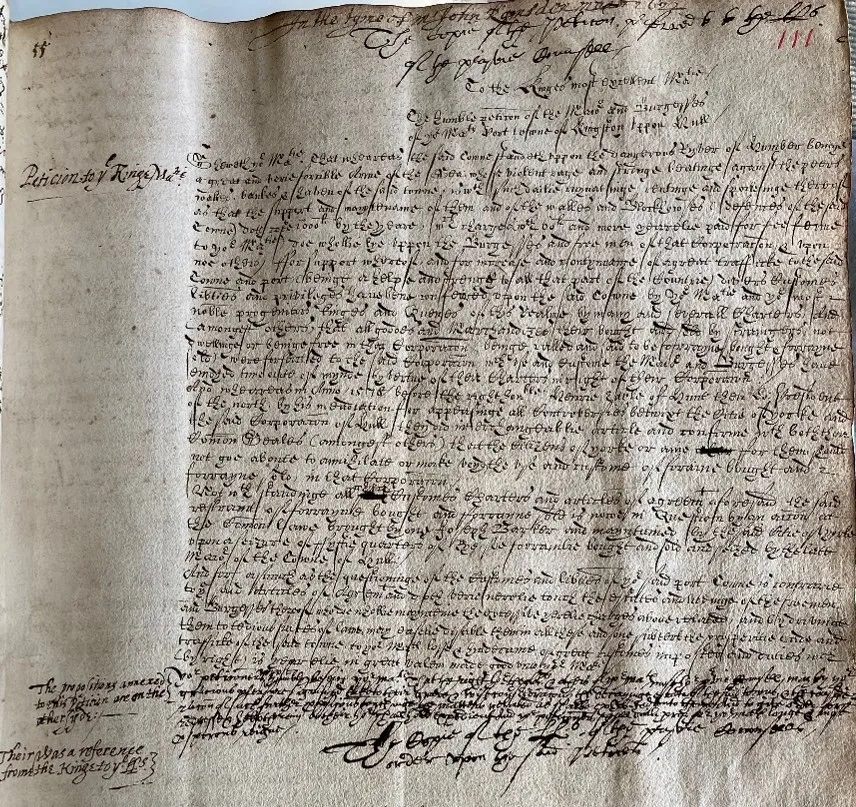We recently published The Power of Petitioning in Early Modern Britain, an open access collection of essays available to read for free from UCL Press. One of the contributors is Hannah Worthen, Postdoctoral Research Associate at the University of Hull. We asked her about her chapter on ‘The Process and Practice of Petitioning in Early Modern England’ and its place in her wider research.
* * *
How did you get interested in early modern petitioning?
My PhD project, a Collaborative Doctoral Partnership with the University of Leicester and The National Archives (2013-2017), had petitions at its heart. The thesis was titled ‘The experience of war widows in mid seventeenth-century England’ and it used the petitions of Royalist and Parliamentarian war widows to local and national jurisdictions in order to reconstruct both their economic experiences of the wars (through, the pensions they were awarded and also in some cases, the lands they had confiscated) and the ways in which they narrated poverty and loyalty in their petitions.
In doing this research I fell in love with petitions. In particular, because the narratives contained within them have the power to connect us with the lives of ‘ordinary’ people in the past, in particular women, in ways that can often feel difficult with the administrative and governance records of the early modern period. They are also usually relatively short, in English, and relatively easy to find via catalogue searches as an added bonus! And so after finishing my PhD I continued to be fascinated by them as a source and particularly, as my chapter explores, the process behind their creation and the practice of actually petitioning in early modern England.
What is the most interesting petition or petitioner that you came across while researching this chapter?
The petition I have chosen doesn’t directly feature in my chapter, but it was one of the ones which inspired this research on the process and practice of petitioning.
The petition was submitted by the Yorkshire widow, Ann Saville, who had her lands confiscated by the Yorkshire Sequestration Committee during the Civil Wars ‘supposeinge her to be a papist w[hi]ch she utterly denyes’.[1] She submitted several petitions to the Committee in London and all of them contain useful insights into the experience of an early modern woman trying to manage lands at a time of great unrest. As, for example, her petitions narrate issues with her tenants exacerbated by ‘many great losses by the severall Armyes & distrac[i]ons in those p[ar]tes’.[2]
What really drew me to this particular petition, however, cannot be gleaned just from a transcription of the words within it. Ann signed all of her petitions, and this is clear from the distinctive form of the letter ‘A’ she uses at the start of her name. Intriguingly, one of her petitions shows that she started writing this letter mid-way through the petition, before the final section, which is not where a petition would usually be signed. Then (perhaps realising her mistake or being corrected by the scribe) the letter stops and is re-started in the proper position at the end of the petition following the familiar sign off ‘And as in duetie bound shall pray &c’. This simple mistake, which endures on the page of the petition held at The National Archives, is a stark reminder of the petitioner behind the petition. Imagining the actual person who collaborated in the creation of this physical document, in the sincere hopes that it would help her to protect her lands and her children, was for me a small, but profound, glimpse into the past.
[1] The National Archives (TNA), SP 23/155 p. 587.
[2] TNA, SP 23/115 p. 581.
What do you hope readers will take away from reading your chapter?
My chapter was written in response to what I saw as a gap in current petitions-based research: to look in more detail at the context of the creation of these sources in order to ensure that the stories and lives contained within them form a robust part of contemporary historical research. This research is now emerging both within this book and in other places and a lively field of research is emerging. So, I hope readers will take from my chapter some of the answers to the question ‘who wrote the petitions anyway?!’ and subsequently to challenge the assumption that if it were not the petitioner, how do we know their role in its creation? Also, to take my chapter as an imperative to not just read the narratives contained within petitions (even though this is certainly valuable research) but also to consider the embodied and spatial experience of petitioning. In doing so, as I argue, we can find the petitioner at the heart of the petition.

How does your work on this chapter fit into your current and future research?
I plan to continue my work into the process of petitioning, particularly its spatial and environmental elements. As a result of my historical research on Hull’s flood histories for the Risky Cities project at the University of Hull I have become particularly interested in the role of collective petitioning in response to historical flood events and other environmental hazards.

I also continue to be drawn to the powerful narratives contained within early modern petitions and their enormous ability to connect us with the past. This is something which I drew on in some community engagement work on behalf of the Risky Cities project, and I am interested in exploring more the potential power of historic petitions in knowledge exchange work with communities today.
